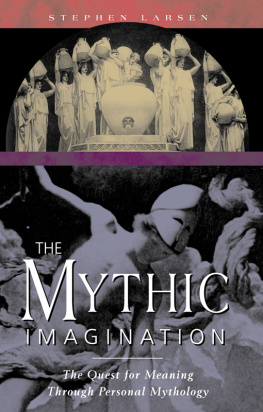Once every people in the world believed that trees were divine, and could take a human or grotesque shape and dance among the shadows; and that deer, and ravens and foxes, and wolves and bears, and clouds and pools, almost all things under the sun and moon, and the sun and moon, were not less divine and changeable. They saw in the rainbow the still bent bow of a god thrown down in his negligence; they heard in the thunder the sound of his beaten water-jar, or the tumult of his chariot wheels; and when a sudden flight of wild ducks, or of crows, passed over their heads, they thought they were gazing at the dead hastening to their rest; while they dreamed of so great a mystery in little things that they believed the waving of a hand, or of a sacred bough, enough to trouble far-off hearts, or hood the moon with darkness.
W. B. Yeats

To my mother and father parents to the body and loving guides to the spirit
Foreword
This study of shamanism, psyche, and society takes us on a journey through history and myth, bringing us directly to the challenge and quandary of contemporary society. It was written and first published in the mid-seventies when the impact of Don Juans teachings [or Carlos Castanedas acute insight] was breaking apart not only anthropology circles but also the mindset of many young westerners who yearned to take the fire ignited in the sixties into their lives in the seventies.
Although legal research and popular experimentation with hallucinogens was diminishing, many people in the United States and Europe yearned to move away from the trend of psychic and social repression characteristic of that time in order to discover through other means the deeper substrate of history and mythology resident in the psyche of all humans no matter what culture, what tradition. The bitter and wild flavor of the shamans initiatory journey was on the tongue of many people in our own culture who had not heard of these seers and healers.
Between Carlos Castaneda, mythologists Joseph Campbell and Mircea Eliade, and a few intrepid anthropologists whose teachings and books became patterans along the way for explorers on the relatively uncharted territory of shamanism, this ancient tradition has found itself in the focus not only of anthropology and mythology, but also such diverse disciplines as psychology, ecology, and ethnopharmacology.
To this end, Steve Larsens study on shamanism and mysticism makes an important contribution to the contemporary literature dealing with these masters of ecstacy. In this beautifully written text, Larsen enters the lair of the shaman and the schizophrenic. He calls forth a number of the most vivid mythic themes that weave through shamanic cultures. This material is always displayed against the background of present-day society. We are reminded that these patterns, these songs and seeings, are part of our own lives today. The shamanic influence can connect us not only with our past, but also show us how to enter the future in a sane and compassionate manner. It is well over a decade since The Shamans Doorway was written, but like shamanism itself, the content of this volume is timeless.
Joan Halifax
Preface to the Second Edition
When The Shamans Doorway was first published thirteen years ago it proposed a bold set of assumptions derived from the challenge of its subject. My goal was to invite modern men and women to join me in an ancient quest, a re-awakening to the spiritual universe which has always lain just beyond the borders of disbelief and secular materialismbeyond, it would seem, the boundaries of our present world-view. I had no way of knowing if anyone would respond to my self-appointed mission. Was I on the path of the true visionary, I wondered, or rather on that of the mad prophet beckoning the unwary into the unknown? At the time, despite the work of Eliade and others, shamanism was still a somewhat recondite field known mainly to anthropologists. How could it have relevance to the lives of people now?
Since then (and this is also the shamans joy) I have seen confirmation of my personal vision and its transpersonal relevance; the book seems able to speak to the minds and hearts of many people. From a variety of places and professions I have received feedback more important to me than reviews or book sales, indicating that The Shamans Doorway has touched peoples lives. Moreover, within a few years a small but very special group of people were indeed becoming a new species of shaman. Is it, I have wondered, that the archetypal subsoil of the North American continent invites the personal vision quest? Not necessarily fully cognizant of what they are doing, on the very mounds and middens of Native American communities, todays young people are enacting time-honored rituals, heeding their dreams, undertaking vision quests, participating in shamanic workshops at growth centers, trying to encounter their personal demons. I see now that this contemporary fascination with shamanic process extends far beyond North America. European, Australian, and Japanese people seem equally to be drawn to reviving their visionary path. Shamanism is close to the roots of humankind, not just one ethnicity or tradition.
In 1979 Joan Halifax, originally a scholar of enthnomedicine, published an extraordinary collection of visionary narratives: Shamanic Voices. It was evident how the voices of yesterday spoke clearly and deeply to the hearts of today. Two years later she published the visually rich: Shaman: The Wounded Healer. Also in 1982 anthropologist Michael Harner, who had studied shamanism among the Jivaro of South America, published The Way of the Shaman and began to conduct experiential shamanism workshops. During the next few years the number of vision quests, personal improvement seminars, and spiritual healing courses had increased enormously. Over the course of a decade, this ancient personal-magical-mythical field of endeavor has been blossoming again. The old rhizome has new shoots and flowers.
Though a few individuals through their work and writing are clearly pioneers and initiators of this movement, I do not wish to imply that contemporary shamanism emerged simply as a consequence of their efforts, charismatic as some may be. Rather it is evident that people of integrity everywhere are turning to the inner quest as a vehicle for transformation. We who feel ourselves to be pioneers are simply spokespersons for a vast movement toward personal growth and wholenessa process which Dr. Carl Jung called individuation and defined as the masterpiece of human psychological development. Paradoxical as it may seem, the collective spiritual path of our time seems to be an impulse toward personal refinement and individuality. Each of us seems destined through pain and limitation, as well as joy and success, with many confrontations both inner and outer, to grow personally toward some increasingly archetypal version of our own unique selves.
It is in my own work as a psychotherapist that I have found the most relevance of shamanism for modern people. Life dismembers us, sooner or later, and there would seem to be vast differences in how individual human beings respond to that ultimate challenge. The primordial shamanic tradition has presented a viable pathway for threading that dark labyrinth. It says that in this life we are to live as if death watches over our shoulder. I think it does. The shaman engages in conscious confrontation with death before his/her literal time has come. This is because the inner (spiritual) meaning of death is transformation.
Joseph Campbell, for me an important teacher and friend, showed forth this principle in his own life right up to the time of his recent death. Say yes to life, even though you know it will devour you. Because amongst the obstacles and, to be sure, the cruelties of life are signs that we are on a primarily spiritual adventure (even though it seems to be taking place in what we regard as an unmistakably physical world). The shamanic paththe key to the immortal, adamantine bodylets the beauties and mysteries of life do something more than offset its agonies. Wonder must overcome terror in the balance of things. And the task of the shaman is to embody and transmit this message; to bring meaning and healing into life; and to create a growing sense of accord with the informing root of all being.
Next page











